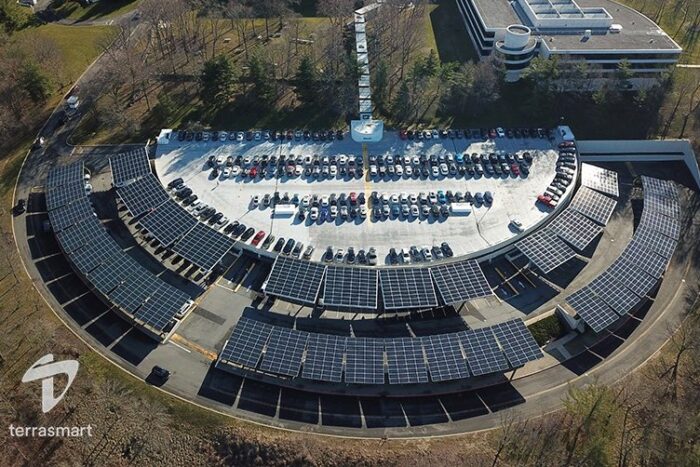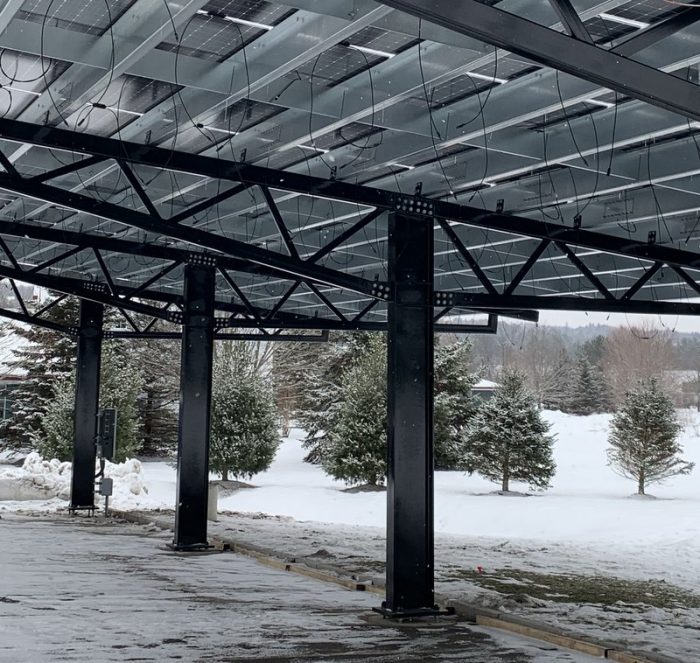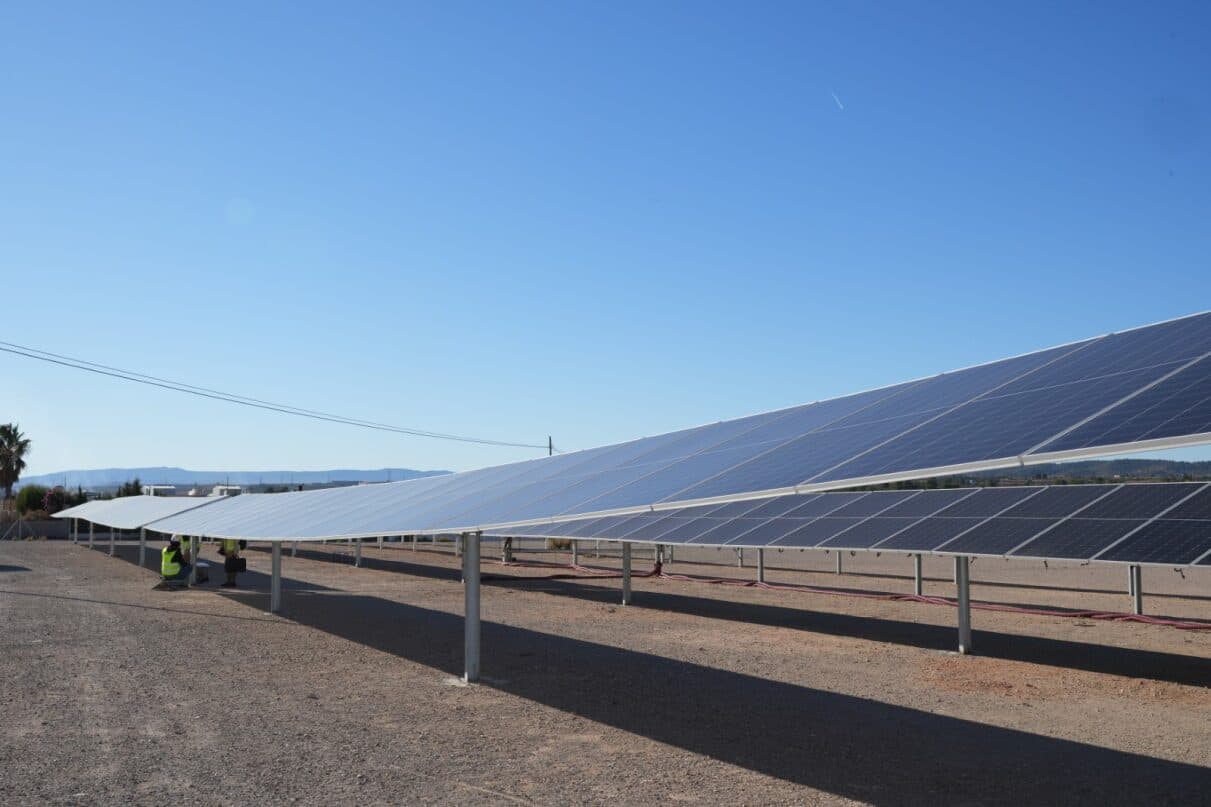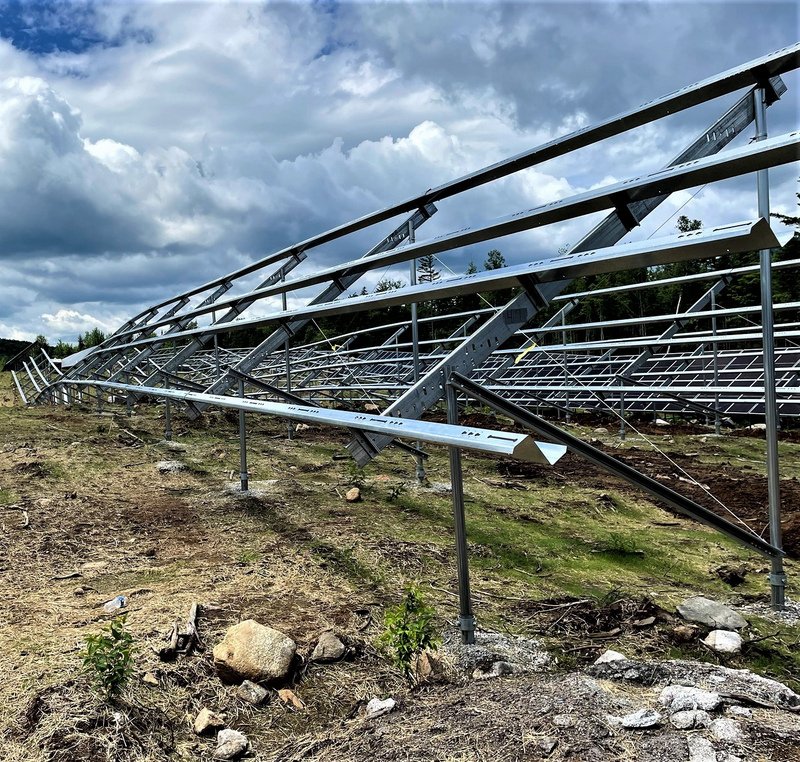Optimizing solar canopies from start to finish

Solar canopies are a huge opportunity to bring solar energy to more commercial and industrial (C&I) spaces – but the costs can be just as huge if not managed from the start. On a recent webinar, solar canopy experts at Terrasmart explained ways to manage risk in solar canopy project development, and how to optimize designs for each project.
“One of our big strengths is trying to reduce risk, and that really starts off in the design and engineering process. We’re trying to be proactive about what the project is and what potential pitfalls could happen,” says Brad Fey, the Canopy Operations Manager of Construction for Terrasmart. “We want to get in front of any potential pitfalls, so that when we’re out in the field we’re not dealing with these on the fly.”
Terrasmart at a glance
Terrasmart is perhaps most widely known for its ground screw-based racking systems – installing over 2 million ground screws will do that – but the Fort Myers, Florida, and Cincinnati, Ohio-based company handles much more. Terrasmart today is a product of the strategic unification of legacy businesses RBI Solar, SolarBOS, Sunfig, and operates as a unit of the publicly traded company Gibraltar Industries. Terrasmart has over 6,000 projects under its belt, covering commercial garage and surface lot canopies, eBOS wiring and combiner boxes, as well as driven pile solutions to fit every type of terrain.
In terms of solar canopies specifically, Terrasmart is a global leader with over 24 GW deployed across seven countries (including the Cincinnati Zoo, a 2024 Solar Builder Project of the Year Award winner). They can handle everything from the design, engineering, and manufacturing, to full scope construction of solar canopies — with a variety of truss and span designs —and integration of subsystems.
“We worked in Puerto Rico, Guam, St. Kitts, and Nevis, Cuba, the Mariana Islands, and Japan,” says Wes Pauley, Technical Canopy Sales Lead for the company. “As soon as I say, ‘we’ve seen it all,’ somebody throws us a curveball by bringing us a project with a different wind load case, snow load, or different seismic conditions.”
Reducing solar canopy risk and cost
What entails being “proactive about risk” at the outset of a solar canopy project?
“What that means is we’re looking at your underground utilities,” enumerates Fey. “We’re trying to understand if there are easements in place, are there electric lines there, what water mains are going to do, and if there’s a storm drain system.”
If a canopy installer is merely reacting to any restraints they discover, “that’s when you start seeing costs,” says Fey. “But we try to get that information up front and understand, for example, if there’s rock underground or if there are restraints because of the property line setbacks. Anticipating these issues, we can design the project to reduce the potential impact and cost.”
Minimizing piles is one key to controlling cost. “One of the things we always try to do is reduce the amount of penetrations into the ground. That’s where a lot of your risk is going to be in your subsurface conditions,” says Pauley.
Apart from anticipating potential problems, careful canopy design can hold down costs. “Steel can have a big cost impact. Are you getting the most PV on top of your steel to bring down that price per Watt?” asks Pauley.
Scheduling space use
“You [have to] know what the accessibility of the site is. If it’s a lot of parking lot, it may be filled daily. We look and say ‘for an efficient install, we would like to have this many spots. We need this much room so we can move our crews across in an efficient manner,’” notes Fey. “If the customer can’t provide us with that, we see what else we can do to pivot and get the schedule set before we start installing that project.”
Determine solar canopy foundations

There’re a variety of foundation opportunities out there for canopies, and depending on the geotech and the site conditions, certain foundations are better than others.
“Foundations are one of the things we take a look at from the get-go,” Fey says. “We have done helicals, steel foundations, and cast piles. It just depends on what the site needs and what’s the most economical foundation.”
One foundation layout consideration is ground coverage. “We’re really trying to maximize PV coverage across your parking lot. And we can achieve this by basically spanning over the driveways. So instead of just trying to cover the parking spaces, we’re actually covering the drive lanes that are between the parking spaces,” Fey points out.
Design to fit any parking lot
Another key point of emphasis is the ability to adapt canopy technology to fit any shape parking lot.
“There are diagonal spaces, there are back-to-back spaces, there are aisle structures, which have parking back-to-back and front-to-front. There’s perimeter parking, and there’s one-row car parking. We customize our canopies to really fit into your parking lot,” says Fey.
Beyond conforming to any lot footprint, the Terrasmart canopies also can incorporate top mount or under-mount panel designs. “With the decking underneath the purlins, you’re basically hiding all the purlins, the wiring and all the conduit to get more of a clean look. Think of it more as like a gas station canopy,” says Fey.
Drainage, snow, and aesthetics
Snow load is also a consideration in designing the slope and directions of sections of the array. “We can basically funnel everything [rain and snow] toward the middle. We can do alternating slopes on those inverted areas, so we can have one side sloped seven degrees while the other side slopes one degree,” Fey says, noting Terrasmart engineers have designed for slopes as steep as 10 and 15 degrees. “Whatever you’re looking for in a type of configuration, we can make happen.”
Beyond slope control, adding gutters will capture and direct water flow from the canopy. “Typically, on these structures, we’ll install a gutter system to help collect any type of snow or ice that may fall, preventing it from falling down into the parking lot,” Fey notes.
“With all of our canopies, we offer the options for gutters and downspout systems. When we’re collecting the water, we can mitigate the impact, drain it into an underground retention system, or drain it out to the parking lot, or even out to a berm behind it.”
Aesthetics, finally, can also be enhanced on a canopy array. “We can trim out the purlins. We can do them in colors. It’s a more sophisticated aesthetic feel that gives you more of a finished edge around the whole canopy structure,” says Fey.
Conclusion
Bottom line, each solar carport and canopy project is unique and requires the right partner to ask the right questions, and provide solutions to overcome any obstacle — because they can be overcome. For more details on Terrasmart’s approach to solar canopies, watch the full webinar:
Charles W. Thurston is a freelance contributor for Solar Builder.





Comments are closed here.